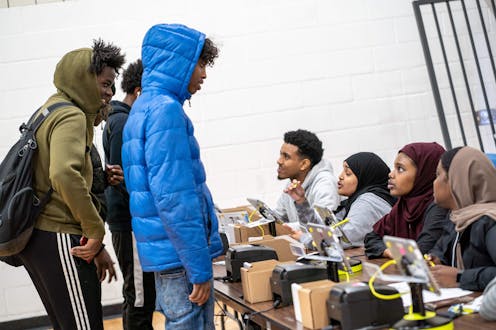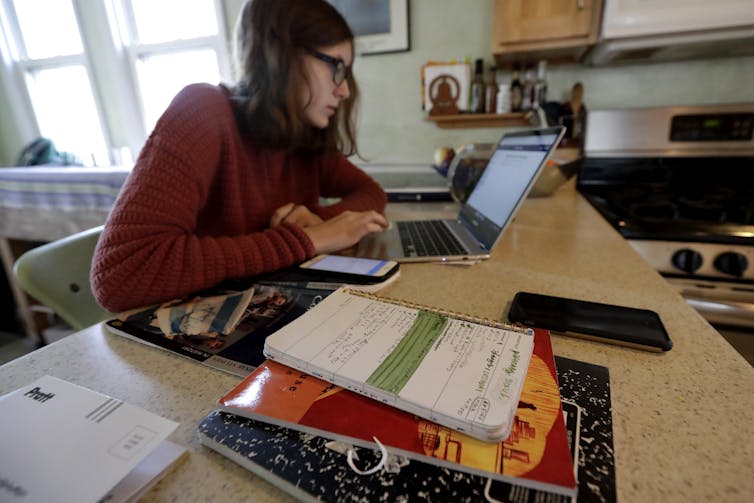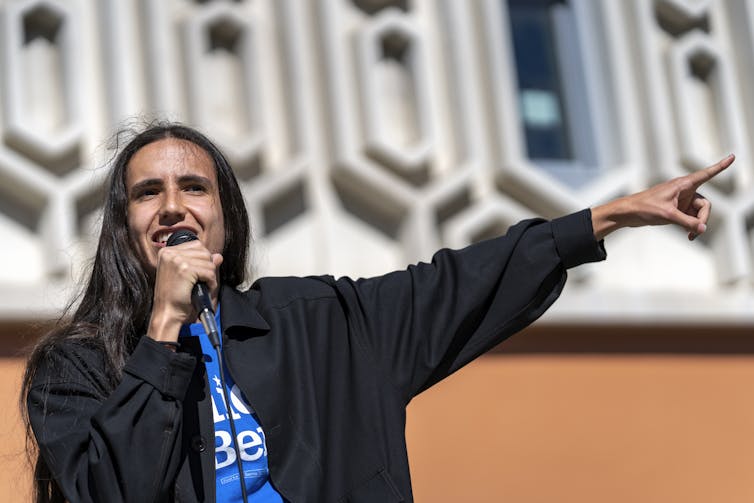How to reach young voters when they're stuck at home
Young voters are important to the continuity of democracy because voting at a young age leads to continued voting throughout life. This year more than most, they'll have a hard time getting started.

Colleges across the U.S. have sent students home. High schools – and their elementary and middle-school counterparts – have moved operations online.
As scholars of young people’s political involvement and activity, we find that this presents a new set of challenges not only for campaigns, but also for democracy.
This election season will be unlike any other. More than a dozen states postponed their Democratic Party primaries. Campaigns canceled all in-person events.
Young voters are important to the continuity of democratic society in the U.S., because voting is a habit: Starting early leads to continued voting.
By our analysis, more than 15 million youth are newly eligible to vote in their first presidential election in November – and these first-time voters make up almost one-third of all 18- to 29-year-olds eligible to vote in the fall. They’re not in campaigns’ databases either, especially if they are not yet registered to vote, so the political machines’ get-out-the-vote systems won’t reach them.
At the Center for Information & Research on Civic Learning and Engagement, part of Tufts University’s Jonathan M. Tisch College of Civic Life, we’ve spent nearly two decades researching how best to grow, inform and mobilize young potential voters. Our findings reveal several key actions that parties, campaigns, advocacy organizations, educators and journalists can take to help ensure that all young people are prepared and motivated to vote in the 2020 election and beyond:
1. Look beyond the college campus
Universities are valuable sites for voter education and engagement, but campaigns’ and other political organizations’ usual focus on campus-based voter outreach has historically left out most young people. At any given time, 45% – less than half – of youth ages 18 to 22 are enrolled in college.
With so many students away from their college campuses now, campaigns and organizers will have to diversify their strategies to reach more young people, in or out of the virtual classroom. In the long run, that shift to be more inclusive of noncollege youth may strengthen democracy as a whole.

2. Discuss elections and voting in at-home learning
Public schools have a responsibility to prepare their students to participate in democracy. In more than two dozen states, policies or statutes explicitly mandate or recommend that schools facilitate voter registration for their students. That responsibility does not end because students are not physically in school. Millions of high schoolers are now participating in online or at-home learning, which could include content about elections and voting.
Many high school seniors are already old enough to vote – or will be by November. More than 20 states allow people to register to vote before their 18th birthdays, if they will be 18 on or before Election Day. Our research on “growing voters” offers ideas for election administrators and nonpartisan community groups to reach diverse groups of young people through high schools, even if students aren’t in classrooms.
3. Focus on online voter registration
Registering to vote sooner rather than later is important. It makes voters visible to campaigns that rely on lists of registered voters for outreach. Research shows that contact by a political campaign or group supporting a candidate is linked to a higher likelihood to vote.
Online voter registration is a good way to support an increase in voter participation because it can make it easier for young people and other new voters to register. It’s even more vital now that so much must be done remotely.
Currently 38 states and Washington, D.C., have online registration, but its availability alone isn’t enough. That’s especially true for young people from low-income backgrounds and marginalized communities. In one CIRCLE study of low-income youth, we found that only 17% of young people across several states with online registration successfully used it. Many respondents shared that they ran into problems trying to do so or were unaware it was an option.
Local voter-registration groups, as well as state and local election administrators, can invest in widely promoting online voter registration and develop strategies to help young people with the process.
4. Remember there are many ways to reach youth
Our polling from the 2018 midterms highlighted how youth learned about the election: Many did so on social media but also from friends, family and classmates.
As young people interact less in person in the coming weeks and months, campaigns and organizations will need to invest in strategies that take into account who young people are already talking to online – especially those who can serve as trusted sources of information.
5. Emphasize deeper, sustained digital contact
Public health recommendations to engage in social distancing and avoid in-person contact will make digital organizing and outreach an even more critical part of the 2020 election cycle.
But the goal should be to make digital contact feel more like personal contact. One-off text messages and social media campaigns can be important, but it’s much more effective to engage youth by building relationships, listening to their priorities, sustaining contact over time and creating opportunities for them to use their skills.

6. Support young leaders
Building new connections with young potential voters is always difficult; restrictions on events and in-person canvassing will make it even harder. But youth leaders and organizers, many of whom have spent recent years growing movements related to issues like gun violence and climate change, may already have the experience, skills, networks and trust to effectively approach youth in their communities. Those leaders may be interested in joining electoral outreach efforts.
7. Strengthen media connections
During both public health emergencies and election seasons, the media plays a critical role in keeping people informed. Many young people may now rely even more on their local media or news broadcast for information. This presents an opportunity for media organizations to think of youth as a critical audience. They could build trust by partnering with young people in order to include their voices through collaborative digital storytelling, projects that share the information a diversity of youth need to participate, or highlighting what diverse youth are already doing to boost engagement. Accurate and actionable election information is especially critical for people new to the voting process.
8. Pay attention to the issues
Young people care deeply about issues like health care, education, employment, economic justice and racial justice. They are motivated to participate in elections when they see candidates and movements addressing what matters to them and to their communities. Some may be experiencing firsthand, for the first time, how policy decisions play out in ways that drastically shape their lives and the lives of their loved ones.
The coronavirus outbreak and the resulting socioeconomic effects directly connect to many longstanding political issues that matter to youth. For example, young people are at higher risk of reduced employment during the pandemic. This presents an opportunity to underscore the importance of youth engagement in the democratic process as a way for them to explicitly influence crucial issues.
[Deep knowledge, daily. Sign up for The Conversation’s newsletter.]
Abby Kiesa is the Director of Impact at CIRCLE, a national research center on youth civic education and engagement at Tufts University's Tisch College of Civic Life. Abby has worked on research projects funded by private foundations including: the Charles F. Kettering Foundation, Youth Engagement Fund, the Democracy Fund, the Spencer Foundation, CloseUp Foundation, Bonner Foundation, Ford Foundation, Corporation for National and Community Service, The Pew Charitable Trusts, S.D. Bechtel, Jr. Foundation, MacArthur Foundation, and the Omidyar Network. She is affiliated with Rock the Vote's Democracy Class (Advisory Council), DoSomething.org (Civic Engagement Advisory Board), Generation Citizen/Vote16USA (Advisory Board).
Kei Kawashima-Ginsberg is the Director of CIRCLE. CIRCLE receives funding from private foundations such as the Ford Foundation, Democracy Fund, MacArthur Foundation, McCormick Foundation, and the Youth Engagement Fund to conduct nonpartisan research about youth and Civic Education and Engagement. CIRCLE also receives indirect funding from the National Endowment for Humanities and the Hewlett Foundation through its nonpartisan partner organizations that receive funding directly from these entities.She is affiliated with the Democracy Works and Generation Citizen as a director of national boards and serve as advisory member for the American Bard Association Standing Commission on Public Education, Project Citizen Z at Education Week, and Project on Information Literacy. She does not receive compensation from these roles.
Read These Next
Chile elects most right-wing leader since Pinochet – in line with regional drift, domestic tendency
José Antonio Kast, who has run for the presidency several times, successfully seized on widespread…
Epstein’s victims deserve more attention than his ‘client list’
Powerful men connected to Jeffrey Epstein are named, dissected and speculated about. The survivors,…
The ‘one chatbot per child’ model for AI in classrooms conflicts with what research shows: Learning
AI tutors are often held up as an ideal, but prioritizing individualized teaching can detract from the…






